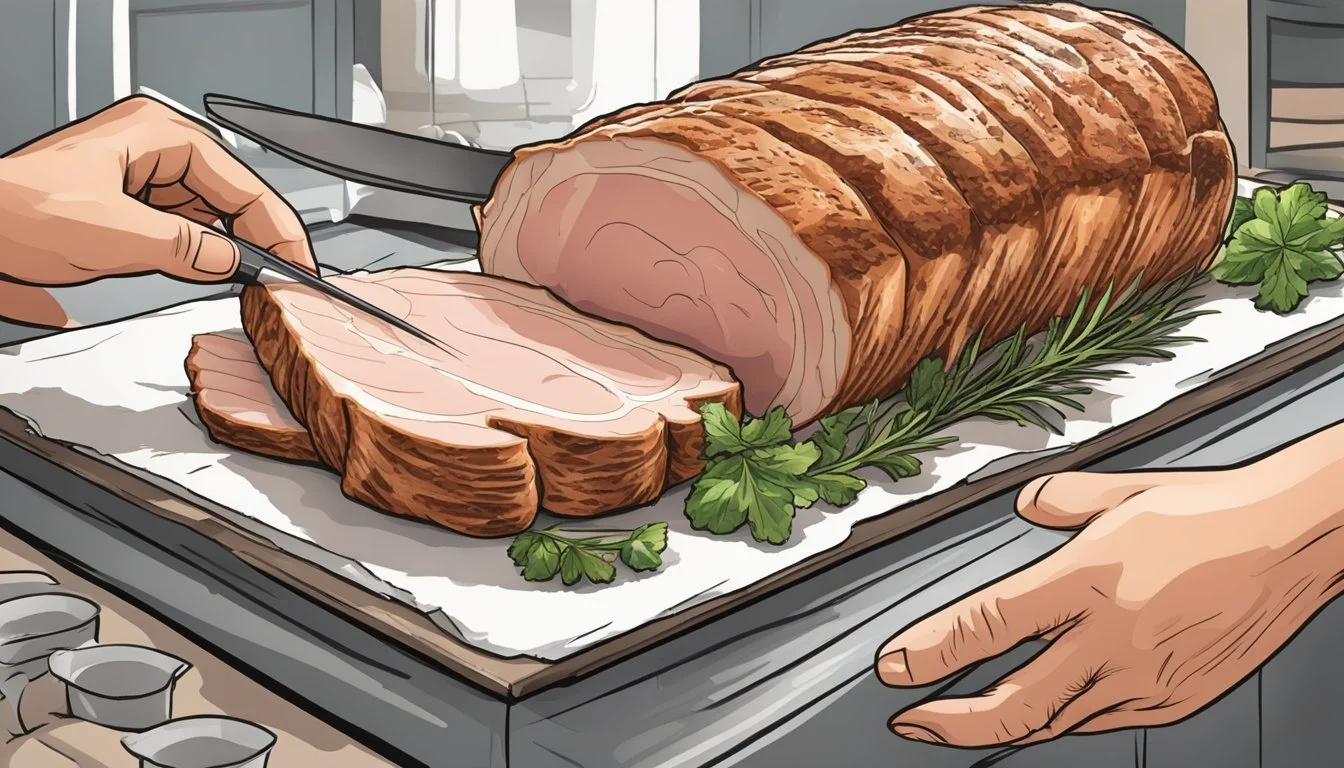How to Cook a 3lb Pork Loin
Tender and Juicy Results
Cooking a 3lb pork loin can be a rewarding culinary experience. This versatile cut of meat offers a perfect balance of flavor and tenderness when prepared correctly. A 3lb pork loin typically requires about 60-75 minutes of cooking time in a preheated 350°F (175°C) oven, or until the internal temperature reaches 145°F (63°C).
A well-cooked pork loin boasts a juicy interior and a golden-brown exterior. To achieve this, seasoning plays a crucial role. A simple blend of salt, pepper, garlic, and herbs like rosemary or thyme can elevate the natural flavors of the meat. Searing the pork loin before roasting adds an extra layer of taste and texture.
For those seeking a foolproof method, using a meat thermometer ensures the pork loin reaches the ideal temperature without overcooking. Resting the meat for 5-10 minutes after cooking allows the juices to redistribute, resulting in a more succulent roast. This easy-to-follow approach yields a delicious centerpiece for any meal.
Selecting the Perfect Pork Loin
Choosing the right pork loin is crucial for a successful roast. The cut, size, and quality of the meat all play important roles in the final result.
Considering Size and Type
Pork loins come in various sizes, typically ranging from 2 to 5 pounds. For a 3-pound roast, look for a cut that's uniform in thickness to ensure even cooking.
Boneless pork loins are popular for their ease of preparation and slicing. They're leaner and cook faster than bone-in options.
Bone-in pork loins offer more flavor but require longer cooking times. The bone helps retain moisture and adds depth to the meat's taste.
Choose based on your cooking time and preferred flavor profile. Boneless cuts are ideal for quicker meals, while bone-in roasts shine in slow-cooked dishes.
Understanding Meat Quality
High-quality pork loin should have a pinkish-red color with some marbling. Avoid meat that's pale or has dark spots.
Look for meat with a thin layer of fat on one side. This fat cap adds flavor and helps keep the roast moist during cooking.
Fresh pork loin should have little to no odor. A strong smell may indicate the meat is past its prime.
Check the packaging date and opt for the freshest cut available. This ensures the best taste and texture in your finished dish.
Choose pork loins from reputable sources. Many stores offer hormone-free or organic options for health-conscious consumers.
Preparation Essentials
Proper preparation is key to achieving a flavorful and juicy pork loin roast. Three crucial steps will set you up for success: trimming the fat cap, brining, and marinating.
Trimming the Fat Cap
A well-trimmed fat cap enhances the pork loin's texture and flavor. Leave about 1/4 inch of fat on top of the roast. This layer helps keep the meat moist during cooking.
Use a sharp knife to carefully remove excess fat. Make smooth, even cuts to avoid gouging the meat. The remaining fat will render during roasting, basting the pork with its own juices.
A properly trimmed fat cap allows for better seasoning penetration and more even cooking. It also creates a crispy, flavorful exterior when roasted.
Brining for Juiciness
Brining is an effective technique to ensure a juicy pork loin. Create a basic brine solution with 1/4 cup kosher salt and 1/4 cup sugar per quart of water.
Submerge the pork loin in the brine for 2-4 hours in the refrigerator. This process helps the meat retain moisture during cooking.
After brining, rinse the pork loin thoroughly and pat it dry with paper towels. This step removes excess salt from the surface.
Brining not only adds moisture but also enhances the pork's natural flavor. It's especially useful for leaner cuts like pork loin.
Marinating for Flavor
Marinating infuses the pork loin with additional flavors. Create a simple marinade with olive oil, minced garlic, dried herbs, and black pepper.
Avoid using acidic ingredients like lemon juice or vinegar, as they can toughen the meat. Instead, focus on oil-based marinades with herbs and spices.
Place the pork loin in a resealable plastic bag with the marinade. Refrigerate for 2-8 hours, turning occasionally to ensure even coverage.
Before cooking, remove the pork from the marinade and pat it dry. This step ensures proper browning in the oven.
For added flavor, consider rubbing the exterior with a mix of garlic powder, dried thyme, and dried rosemary before roasting.
Seasoning Your Pork Loin
Properly seasoning a pork loin enhances its flavor and creates a delicious crust. A well-seasoned roast balances savory, aromatic, and sometimes sweet elements to complement the meat's natural taste.
Herb and Spice Combinations
Classic pork loin seasonings include rosemary, thyme, sage, and garlic. Mix 2 tablespoons of dried herbs with 1 teaspoon each of salt and black pepper. For a savory-sweet blend, combine 1 tablespoon brown sugar with 1 teaspoon each of paprika, onion powder, and dried oregano.
Experiment with different combinations:
Italian-style: Basil, oregano, and fennel seeds
Smoky: Smoked paprika, cumin, and chili powder
Citrus-herb: Lemon zest, parsley, and tarragon
For added depth, incorporate 1/2 teaspoon of ground mustard or a pinch of crushed red pepper flakes.
Applying Seasonings Evenly
To ensure uniform flavor, pat the pork loin dry with paper towels before seasoning. This step helps the spices adhere better to the meat's surface.
Rub the seasoning mixture all over the pork loin, including the ends. Use your hands to massage it into the meat, creating an even coating. For optimal results, season the pork loin at least 30 minutes before cooking.
Consider scoring the fat cap in a diamond pattern. This technique allows the seasonings to penetrate deeper into the meat and creates an appealing presentation.
For an extra layer of flavor, brush the seasoned pork loin with olive oil or Dijon mustard before roasting. This step helps form a flavorful crust during cooking.
Cooking Methods
Pork loin can be prepared using various techniques to achieve delicious results. The choice of method impacts flavor, texture, and cooking time.
Roasting Perfection
Roasting is a popular method for cooking a 3 lb pork loin. Preheat the oven to 325-350°F (163-177°C). Place the seasoned pork loin in a roasting pan, fat side up.
Cook for approximately 20-30 minutes per pound, or until the internal temperature reaches 145°F (63°C). Use a meat thermometer to check doneness.
Let the roast rest for 5-10 minutes before slicing. This method yields a juicy interior with a flavorful crust.
Exploring Slow Cooking
Slow cooking offers a hands-off approach to preparing pork loin. Place the seasoned 3 lb roast in a slow cooker or crockpot.
Add liquid such as broth or wine for moisture. Cook on low for 6-8 hours or on high for 4-5 hours.
The result is tender, fall-apart meat. This method is ideal for busy cooks or those who prefer a softer texture.
Trying the Grill
Grilling imparts a smoky flavor to pork loin. Preheat the grill to medium-high heat.
Sear the pork loin on all sides, then move to indirect heat. Close the lid and cook for about 1-1.5 hours.
Monitor the internal temperature closely. Remove the pork when it reaches 145°F (63°C).
Let it rest for a few minutes before slicing. Grilling creates a delicious crust while keeping the inside juicy.
Cooking the Pork Loin
Preparing a succulent 3-pound pork loin requires attention to cooking method, temperature, and timing. Each technique offers unique flavors and textures.
Using the Oven
Preheat the oven to 375°F (190°C). Place the pork loin in a roasting pan, fat side up. Season with salt, pepper, and desired herbs. Cook for 20-25 minutes per pound, or about 60-75 minutes total.
Use a meat thermometer to check doneness. The internal temperature should reach 145°F (63°C) for medium-rare. Let the roast rest for 5-10 minutes before slicing.
For a crispy exterior, start at 450°F (232°C) for 15 minutes, then reduce to 375°F (190°C) for the remaining time. This method creates a flavorful crust while maintaining juicy meat inside.
Utilizing the Slow Cooker
The slow cooker offers a hands-off approach to cooking pork loin. Place the seasoned roast in the slow cooker with 1/2 cup of liquid (broth or wine). Cook on low for 6-8 hours or high for 4-5 hours.
Add vegetables like carrots, onions, and potatoes for a complete meal. The slow, moist heat ensures tender, juicy meat. Check the internal temperature with an instant-read thermometer.
For added flavor, sear the pork loin in a hot skillet before placing it in the slow cooker. This step creates a caramelized exterior and locks in juices.
Grilling Outdoors
Grilling imparts a smoky flavor to pork loin. Preheat the grill to medium-high heat (375-400°F or 190-204°C). Brush the grill grates with oil to prevent sticking.
Place the seasoned pork loin on the grill. Cook for 18-20 minutes per pound, turning every 5 minutes to ensure even cooking. Use indirect heat to avoid flare-ups and prevent burning.
A meat thermometer is crucial for grilling. Remove the pork when it reaches 140°F (60°C) internally. Tent with foil and let it rest for 5-10 minutes. The temperature will continue to rise to the safe 145°F (63°C).
Finishing Techniques
Proper finishing techniques are crucial for achieving a juicy, tender pork loin. These final steps can elevate your dish from good to great.
Resting for Tenderness
After removing the pork loin from the oven, let it rest for 10-15 minutes. This allows the juices to redistribute throughout the meat, resulting in a more tender and flavorful roast. Place the pork on a cutting board and tent it loosely with foil to keep it warm.
Resting prevents the juices from spilling out when you slice the meat. This step is essential for maintaining moisture and ensuring each bite is succulent.
Making Gravy and Pan Juices
While the pork rests, utilize the flavorful drippings in the roasting pan to create a delicious gravy. Pour off excess fat, leaving about 2 tablespoons in the pan.
Place the pan over medium heat and add 1-2 tablespoons of flour. Whisk to create a roux, cooking for 1-2 minutes. Gradually add 1-1.5 cups of broth or water, stirring constantly to prevent lumps.
Simmer the gravy for 3-5 minutes until it thickens. Season with salt and pepper to taste. Strain if desired for a smoother consistency.
Slicing for Serving
Use a sharp knife to slice the rested pork loin against the grain. This technique ensures more tender bites by cutting through the muscle fibers.
Aim for slices about 1/4 to 1/2 inch thick. Thinner slices work well for sandwiches, while thicker cuts are ideal for a main course.
Arrange the slices on a platter, slightly overlapping for an appealing presentation. Drizzle with pan juices or gravy to enhance flavor and moisture.
Garnish with fresh herbs like rosemary or thyme for added visual appeal and aroma. Serve immediately while the pork is still warm and at its juiciest.
Side Dishes and Accompaniments
A well-chosen side dish elevates pork loin from a simple main course to a memorable meal. The right accompaniments complement the meat's flavors and textures while adding variety to the plate.
Selecting Veggies
Roasted vegetables pair exceptionally well with pork loin. Brussels sprouts, crispy on the outside and tender inside, offer a delightful contrast. Carrots, when roasted, bring out their natural sweetness.
Broccoli florets, lightly seasoned and roasted until slightly charred, provide a healthy and flavorful option. For a unique twist, try melting cauliflower - a technique that results in a creamy, indulgent side dish.
Grilled or sautéed asparagus spears add a touch of elegance. Their slight bitterness balances the richness of the pork. A medley of roasted root vegetables, including parsnips and turnips, offers diverse flavors and textures.
Choosing Starches
Mashed potatoes are a classic accompaniment to pork loin. For a twist, consider garlic mashed potatoes or a cauliflower mash for a lower-carb option.
Roasted potatoes, crispy on the outside and fluffy inside, are another excellent choice. Seasoned with herbs like rosemary or thyme, they complement the pork beautifully.
Mac and cheese elevates the meal to comfort food status. An upscale version with brie and white cheddar adds sophistication. For a lighter option, try a pasta salad with orzo, pesto, and mozzarella.
Polenta, baked with fresh tomatoes and Parmesan, offers an Italian-inspired side. Its creamy texture contrasts nicely with the pork's firmness.
Pairing with Fruits
Apples and pork are a classic combination. Sautéed apple slices with cinnamon make a sweet and tangy side dish. For a more savory option, try roasted apples with onions and thyme.
A fig and arugula salad provides a fresh, peppery contrast to the rich pork. The sweetness of the figs balances the meat's savory flavors.
Roasted pears offer a sophisticated fruit option. Their subtle sweetness complements the pork without overpowering it. For a tropical twist, grilled pineapple brings a burst of flavor and acidity to cut through the richness of the meat.
Serving Suggestions
A perfectly cooked 3lb pork loin deserves elegant presentation and thoughtful pairings. Proper plating techniques and beverage choices can elevate this tender and delicious dish for family dinners or company meals.
Plating Techniques
Slice the pork loin into medallions about 1/2 inch thick. Arrange 3-4 slices in a fan pattern on each plate. Drizzle any pan juices over the meat.
For a rustic presentation, serve family-style on a large wooden board. Garnish with fresh herbs like rosemary or thyme sprigs.
Add color with roasted vegetables like carrots, Brussels sprouts, or sweet potatoes alongside the pork. A small mound of mashed potatoes or wild rice pilaf complements the meat well.
For a healthier option, serve over a bed of wilted spinach or kale. Include a wedge of lemon for squeezing over the pork just before eating.
Pairing with Wine and Beverages
A medium-bodied red wine pairs excellently with pork loin. Try a Pinot Noir, Merlot, or Chianti. These wines have enough acidity to cut through the richness of the pork without overpowering its flavor.
For white wine lovers, opt for a lightly oaked Chardonnay or a crisp Riesling. These complement the pork's mild flavor while providing a refreshing contrast.
Beer enthusiasts might enjoy a Belgian ale or amber lager with their pork loin. The malty sweetness of these beers enhances the meat's savory qualities.
Non-alcoholic options include sparkling apple cider or a mocktail made with cranberry juice and soda water. These provide a tart, effervescent counterpoint to the rich pork.
Storing and Reusing Leftover Pork Loin
Proper storage and creative reuse of leftover pork loin can maximize its flavor and nutritional value. Implementing effective storage techniques and exploring inventive recipes ensures no part of this delicious cut goes to waste.
Optimal Storage Methods
Refrigerate leftover pork loin within two hours of cooking. Place the meat in an airtight container or wrap it tightly in plastic wrap or aluminum foil. Properly stored, cooked pork loin remains safe to eat for 3-4 days in the refrigerator.
For longer-term storage, freeze the pork loin. Cut it into portions for easier thawing and use. Wrap each portion in freezer paper or plastic wrap, then place in a freezer bag. Remove as much air as possible before sealing. Label the package with the date and contents.
Frozen pork loin maintains its quality for up to 2-3 months. When ready to use, thaw in the refrigerator overnight for best results.
Creative Leftover Ideas
Transform leftover pork loin into quick and easy meals. Slice it thinly for sandwiches or chop it for salads. Add cubed pork to stir-fries with colorful vegetables for a healthier dinner option.
Create a savory pork fried rice by combining diced pork with cooked rice, eggs, and vegetables. Season with soy sauce and garlic for an Asian-inspired dish.
For a comforting meal, use leftover pork in a casserole. Mix chopped pork with cooked pasta, vegetables, and a creamy sauce. Top with cheese and bake until golden.
Try a pork and bean soup for a hearty lunch. Combine diced pork with canned beans, vegetables, and broth. Simmer until flavors meld for a satisfying meal.








